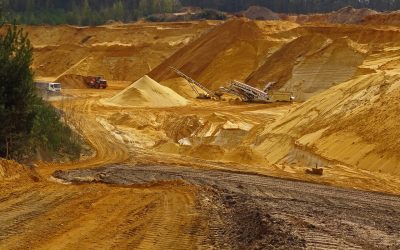Aggregates — such as gravel, sand, or crushed stone — are among the world’s most important building materials. Roughly 60-75% of concrete is comprised of aggregates, and aggregates make up around 90% of paving asphalt. To create strong, stable construction materials, the aggregate used must be clean and meet strict specifications.
Most aggregates are harvested from pits, quarries, lakes, or rivers, then crushed to various specified sizes. Before they can be used in construction, they must be thoroughly cleaned and separated from undesirable materials such as silt and clay, as well as fine dust from the crushing process.
If the aggregates are not sufficiently clean, these contaminants can throw off the chemical balance of the construction materials.
How Are Aggregates Cleaned?
The most common solution is to use water and special equipment to “wash” the aggregates. Some advanced washing equipment can simultaneously wash the aggregates and classify them by size and other properties.
Wet classification works like this: When placed into water, larger particles tend to settle to the bottom first, and the smallest particles remain suspended the longest. The most efficient washing equipment combines the separating properties of water with vibrating screens to filter out and remove dust, known as “fines”, and other contaminants.
A major drawback of the washing process is that it results in wet aggregates. This is where dewatering comes into play.
What Is Dewatering?
After being washed, aggregates need to be dried. Sand, however, is particularly challenging to dry. The process of removing as much water as possible from sand and other aggregates is known as dewatering.
One common method of dewatering sand is the use of dewatering screens. Fine screens are used in combination with gravity and vibrating motors to screen out as much moisture as possible. In other words, dewatering screens work like highly advanced colanders or strainers.
Another common dewatering method is using a hydrocyclone. In the simplest terms, if dewatering screens are like a strainer, then a hydrocyclone is like a salad spinner. It uses centrifugal force to separate water from aggregates.
A third dewatering process is known as a bucket wheel. This is a hydraulic separation method that requires large quantities of water.
Why Is Dewatering Important?
Dewatering serves several critical functions. The first is to ensure that the aggregate is sufficiently dry for use in concrete and other construction materials. The moisture content of concrete, for example, has an enormous effect on the concrete’s durability and strength.
Concrete manufacturers must be able to strictly control moisture levels. Aggregates that contain too much water can cause weak and inferior concrete. Dewatering also plays a key role in reducing operating costs and increasing efficiency.
Drier material is easier to handle, takes up less space, and weighs much less. The reduced weight leads to decreased fuel and transportation expenses. Drier material also shortens stockpile drying time. In addition, the water that is removed from the aggregates during the dewatering process can be re-used, reducing overall consumption.
AEI’s Aggregate Washing and Dewatering Solutions
AEI offers a full range of customized aggregate washing and screening solutions to help improve your operations.
For washing and dewatering sand and other materials we offer The Ortner®. It’s designed to classify, rinse, and dewater sand or other fine materials. It uses less water while consuming less power, creating significant savings for the operator. Contact us online for an equipment quote.
You can also call us directly at 717-656-2131 to speak with our sales team and receive more information.


